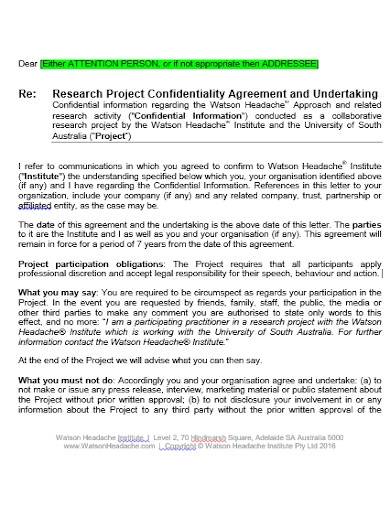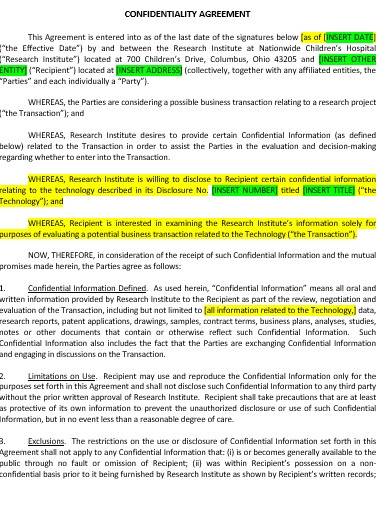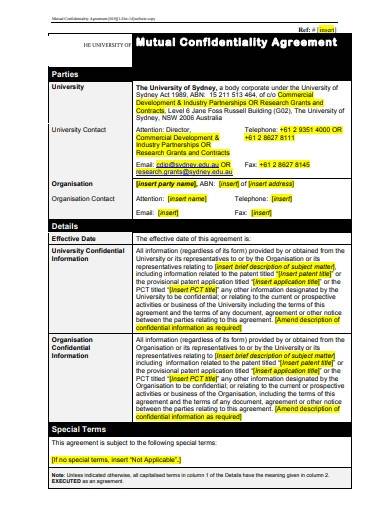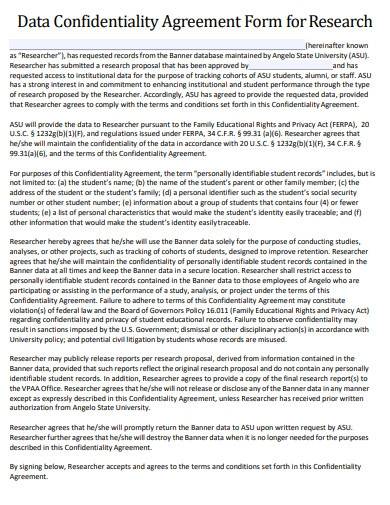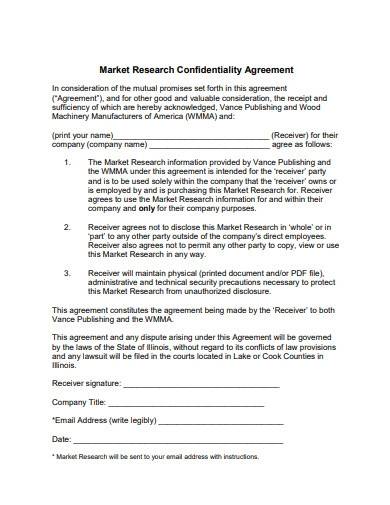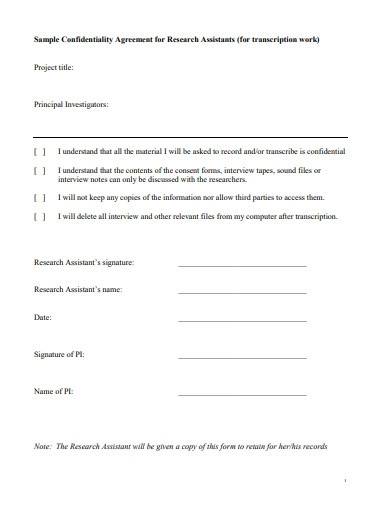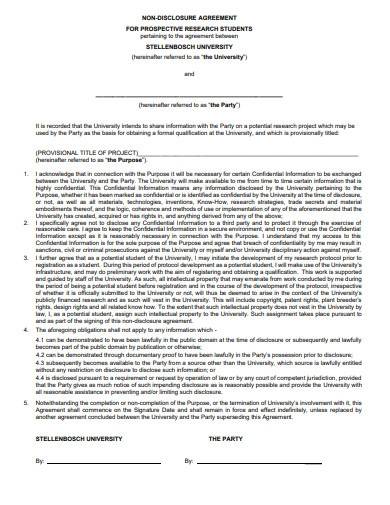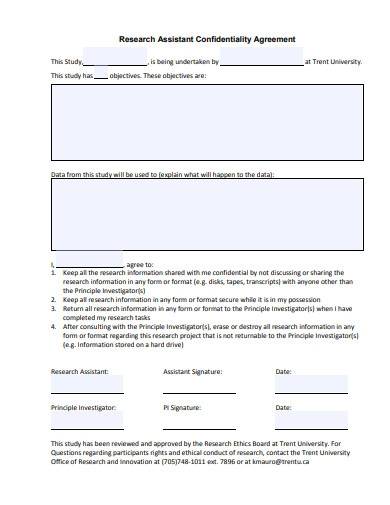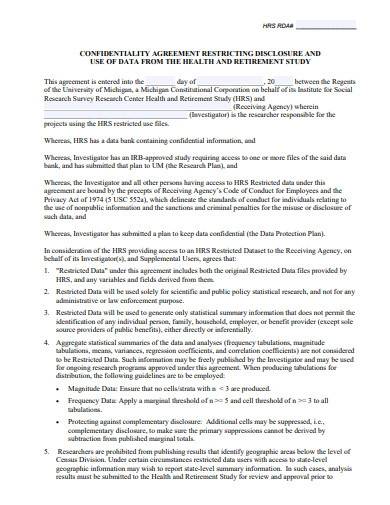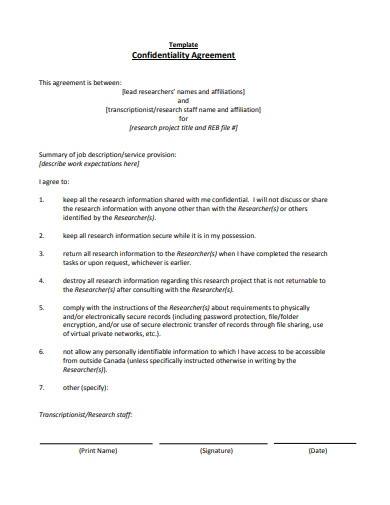When two or more people agree to the same thing at the same time and at the same place, it means that they have reached an agreement about something in particular. Agreements can either be verbal or written, but the most preferred type is the written agreement. That is because they provide concrete evidence of what has been discussed and agreed for a particular transaction. A research confidentiality agreement is a type of agreement that must be put in writing that is because it is lengthy. It is also where specific provisions and information about a research study are written. Let’s find out more about this specific agreement.
FREE 10+ Research Confidentiality Agreement Samples & Templates
Feel free to browse through the research confidentiality agreement samples below to help you learn and familiarize different confidentiality agreement content and format.
1. Research Project Confidentiality Agreement
2. Research Confidentiality Agreement Template
3. Mutual Research Confidentiality Agreement
4. Confidentiality Agreement for Research Assistant
5. Data Research Confidentiality Agreement Form
6. Market Research Confidentiality Agreement
7. Sample Confidentiality Agreement for Research Assistant
8. Research Non-Disclosure Agreement
9. Research Assistant Confidentiality Agreement
10. Research Non Disclosure Agreement Sample
11. Confidentiality Agreement Template
What Is a Research Confidentiality Agreement?
Through research, a lot of new things and phenomena are discovered. New medicine, new vaccine, new strain of viruses, new land, new theories, almost everything is discovered through research. These are wonderful discoveries and must be made known to the public or the whole world. But research studies have its secrets to keep, and it’s the job of every research professional to these secrets off-limits to outsiders and their competition. That is why, in any research facility, new members of a research team are required to sign a research confidentiality agreement.
In a research confidentiality agreement, research professionals are obliged to keep any confidential information from disclosure to a third party or to people who are not involved in the research study. The disclosing party in this agreement is the company or the researcher who provides details about the ongoing research. In business, confidentiality agreements are used to protect trade secrets from getting into the hands of competitors. Through this agreement, information that is not intended for ordinary people to know is safeguarded from leaking. Some confidential information may cause chaos; that is why they must be kept secret.
How to Make a Research Confidentiality Agreement
Writing a research confidentiality agreement can be a daunting task. There are a lot of clauses and sections that you need to include in the document. Everything must also be detailed and specific. But it can be done. There are many ways on how you can make a research confidentiality agreement. Below are some useful tips that will surely be of help.
1. Determine Why You Need It
What is the agreement for? You first need to know what the agreement is for because this will guide you on the type of information and details that you should include. It’s important to have a reason for doing something because it gives you a sense of direction and allows you to focus on what you really need to cover.
2. Know What to Include
Define what information should be treated as confidential. Make a list of the terms and conditions and other important information that you want and need to include in the agreement. You can also find them on sample templates like medical confidentiality agreements, volunteer confidentiality agreements, and client confidentiality agreements. These sample templates make good reference material.
3. Describe What You Want to Exclude
Don’t forget to add the limitations of each party in the agreement. You must be very specific with both what the parties can do and what they cannot do. Include the consequences for a breach of contract that both parties agree on. Since it’s a legally binding agreement, both parties will also be bound to the consequences in case of a breach.
4. Be Specific with the Start and End Date
The specific start and end dates are important in a confidentiality agreement. The agreement must state ho many years the deal is effective, and what circumstances will make it void. This way, confidential information is protected even when an employee leaves the company or resigns.
5. Seek Professional Help
If you already have your agreement ready, but you feel that something is missing, then you should consult a lawyer. Lawyers are knowledgeable when it comes to legal documents, and they can provide you valuable advice to make your agreement document effective.
FAQs
What is another name for confidentiality agreements?
A confidentiality agreement has a number of alternative names, including nondisclosure agreement, confidential disclosure agreement, proprietary information agreement, and secrecy agreement. These are different names, but they serve one purpose, and that is to protect sensitive information from further disclosure.
What are the types of confidentiality agreements?
The three main types of confidentiality agreements are unilateral, bilateral, and multilateral confidentiality agreements. Unilateral confidentiality agreements or one-way confidentiality agreements have one party disclosing confidential information. In a bilateral or two-way confidentiality agreement, both parties anticipate disclosing or sharing of confidential information with each other, and both are expected to protect the information from further disclosure. It is also called a mutual confidentiality agreement. The last type, which is the multilateral confidentiality agreement, involves two or more parties. At least one party in the agreement is expected to disclose information. It also eliminates the need to make separate unilateral and bilateral confidentiality agreements.
The research confidentiality agreement samples and templates above will surely help you come up with a useful and reliable confidentiality agreement. You may also download the samples for free, so make sure to check them out!
Related Posts
FREE 10+ Concurrent Validity Samples & Templates in MS Word | PDF
FREE 10+ Resource Tracking Samples & Templates in MS Word | PDF
FREE 4+ Clinical Case Study Samples & Templates in PDF
FREE 10+ Content Validity Samples & Templates in PDF
FREE 10+ Construct Validity Samples & Templates in MS Word | PDF
FREE 10+ Code of Human Research Ethics Samples & Templates in MS Word | PDF
FREE 10+ Biography Research Report Samples and Templates in PDF
FREE 10+ System Documentation Samples & Templates in MS Word | PDF
FREE 10+ Process Document Samples & Templates in MS Word | PDF
FREE 10+ Action Research Samples & Templates in PDF
FREE 10+ Longitudinal Research Samples & Templates in PDF | MS Word
FREE 10+ Causal Research Samples & Templates in MS Word | PDF
FREE 10+ Client Discovery Samples & Templates in MS Word | PDF
FREE 10+ Null Hypothesis Samples & Templates in MS Word | PDF
FREE 9+ Product Knowledge Samples & Templates in PDF

